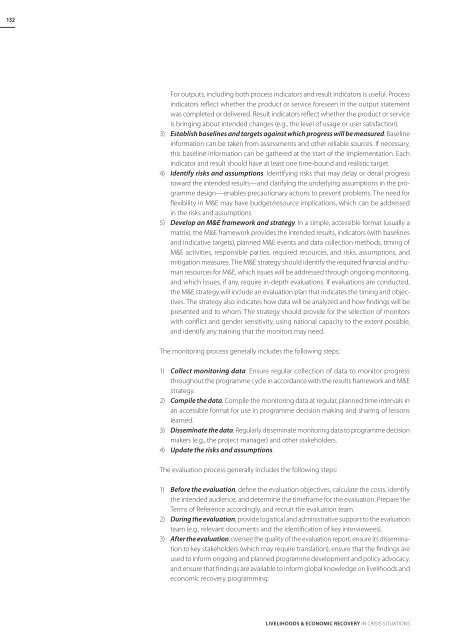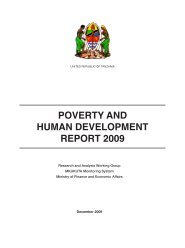Download PDF (4.08 MB) - ReliefWeb
Download PDF (4.08 MB) - ReliefWeb
Download PDF (4.08 MB) - ReliefWeb
You also want an ePaper? Increase the reach of your titles
YUMPU automatically turns print PDFs into web optimized ePapers that Google loves.
132<br />
For outputs, including both process indicators and result indicators is useful. Process<br />
indicators reflect whether the product or service foreseen in the output statement<br />
was completed or delivered. Result indicators reflect whether the product or service<br />
is bringing about intended changes (e.g., the level of usage or user satisfaction).<br />
3) Establish baselines and targets against which progress will be measured. Baseline<br />
information can be taken from assessments and other reliable sources. If necessary,<br />
this baseline information can be gathered at the start of the implementation. Each<br />
indicator and result should have at least one time-bound and realistic target.<br />
4) Identify risks and assumptions. Identifying risks that may delay or derail progress<br />
toward the intended results—and clarifying the underlying assumptions in the programme<br />
design—enables precautionary actions to prevent problems. The need for<br />
flexibility in M&E may have budget/resource implications, which can be addressed<br />
in the risks and assumptions.<br />
5) Develop an M&E framework and strategy. In a simple, accessible format (usually a<br />
matrix), the M&E framework provides the intended results, indicators (with baselines<br />
and indicative targets), planned M&E events and data collection methods, timing of<br />
M&E activities, responsible parties, required resources, and risks, assumptions, and<br />
mitigation measures. The M&E strategy should identify the required financial and human<br />
resources for M&E, which issues will be addressed through ongoing monitoring,<br />
and which issues, if any, require in-depth evaluations. If evaluations are conducted,<br />
the M&E strategy will include an evaluation plan that indicates the timing and objectives.<br />
The strategy also indicates how data will be analyzed and how findings will be<br />
presented and to whom. The strategy should provide for the selection of monitors<br />
with conflict and gender sensitivity, using national capacity to the extent possible,<br />
and identify any training that the monitors may need.<br />
The monitoring process generally includes the following steps:<br />
1) Collect monitoring data. Ensure regular collection of data to monitor progress<br />
throughout the programme cycle in accordance with the results framework and M&E<br />
strategy.<br />
2) Compile the data. Compile the monitoring data at regular, planned time intervals in<br />
an accessible format for use in programme decision making and sharing of lessons<br />
learned.<br />
3) Disseminate the data. Regularly disseminate monitoring data to programme decision<br />
makers (e.g., the project manager) and other stakeholders.<br />
4) Update the risks and assumptions.<br />
The evaluation process generally includes the following steps:<br />
1) Before the evaluation, define the evaluation objectives, calculate the costs, identify<br />
the intended audience, and determine the timeframe for the evaluation. Prepare the<br />
Terms of Reference accordingly, and recruit the evaluation team.<br />
2) During the evaluation, provide logistical and administrative support to the evaluation<br />
team (e.g., relevant documents and the identification of key interviewees).<br />
3) After the evaluation, oversee the quality of the evaluation report, ensure its dissemination<br />
to key stakeholders (which may require translation), ensure that the findings are<br />
used to inform ongoing and planned programme development and policy advocacy,<br />
and ensure that findings are available to inform global knowledge on livelihoods and<br />
economic recovery programming.<br />
Livelihoods & Economic Recovery in Crisis Situations





